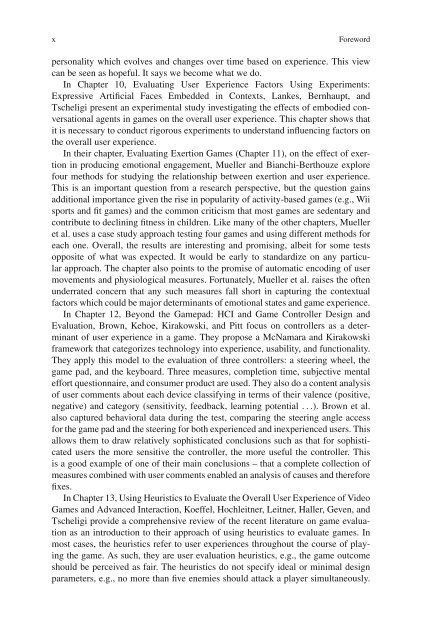Evaluating User Experience in Games: Concepts and Methods - Lirmm
Evaluating User Experience in Games: Concepts and Methods - Lirmm
Evaluating User Experience in Games: Concepts and Methods - Lirmm
You also want an ePaper? Increase the reach of your titles
YUMPU automatically turns print PDFs into web optimized ePapers that Google loves.
x Foreword<br />
personality which evolves <strong>and</strong> changes over time based on experience. This view<br />
can be seen as hopeful. It says we become what we do.<br />
In Chapter 10, <strong>Evaluat<strong>in</strong>g</strong> <strong>User</strong> <strong>Experience</strong> Factors Us<strong>in</strong>g Experiments:<br />
Expressive Artificial Faces Embedded <strong>in</strong> Contexts, Lankes, Bernhaupt, <strong>and</strong><br />
Tscheligi present an experimental study <strong>in</strong>vestigat<strong>in</strong>g the effects of embodied conversational<br />
agents <strong>in</strong> games on the overall user experience. This chapter shows that<br />
it is necessary to conduct rigorous experiments to underst<strong>and</strong> <strong>in</strong>fluenc<strong>in</strong>g factors on<br />
the overall user experience.<br />
In their chapter, <strong>Evaluat<strong>in</strong>g</strong> Exertion <strong>Games</strong> (Chapter 11), on the effect of exertion<br />
<strong>in</strong> produc<strong>in</strong>g emotional engagement, Mueller <strong>and</strong> Bianchi-Berthouze explore<br />
four methods for study<strong>in</strong>g the relationship between exertion <strong>and</strong> user experience.<br />
This is an important question from a research perspective, but the question ga<strong>in</strong>s<br />
additional importance given the rise <strong>in</strong> popularity of activity-based games (e.g., Wii<br />
sports <strong>and</strong> fit games) <strong>and</strong> the common criticism that most games are sedentary <strong>and</strong><br />
contribute to decl<strong>in</strong><strong>in</strong>g fitness <strong>in</strong> children. Like many of the other chapters, Mueller<br />
et al. uses a case study approach test<strong>in</strong>g four games <strong>and</strong> us<strong>in</strong>g different methods for<br />
each one. Overall, the results are <strong>in</strong>terest<strong>in</strong>g <strong>and</strong> promis<strong>in</strong>g, albeit for some tests<br />
opposite of what was expected. It would be early to st<strong>and</strong>ardize on any particular<br />
approach. The chapter also po<strong>in</strong>ts to the promise of automatic encod<strong>in</strong>g of user<br />
movements <strong>and</strong> physiological measures. Fortunately, Mueller et al. raises the often<br />
underrated concern that any such measures fall short <strong>in</strong> captur<strong>in</strong>g the contextual<br />
factors which could be major determ<strong>in</strong>ants of emotional states <strong>and</strong> game experience.<br />
In Chapter 12, Beyond the Gamepad: HCI <strong>and</strong> Game Controller Design <strong>and</strong><br />
Evaluation, Brown, Kehoe, Kirakowski, <strong>and</strong> Pitt focus on controllers as a determ<strong>in</strong>ant<br />
of user experience <strong>in</strong> a game. They propose a McNamara <strong>and</strong> Kirakowski<br />
framework that categorizes technology <strong>in</strong>to experience, usability, <strong>and</strong> functionality.<br />
They apply this model to the evaluation of three controllers: a steer<strong>in</strong>g wheel, the<br />
game pad, <strong>and</strong> the keyboard. Three measures, completion time, subjective mental<br />
effort questionnaire, <strong>and</strong> consumer product are used. They also do a content analysis<br />
of user comments about each device classify<strong>in</strong>g <strong>in</strong> terms of their valence (positive,<br />
negative) <strong>and</strong> category (sensitivity, feedback, learn<strong>in</strong>g potential ...). Brown et al.<br />
also captured behavioral data dur<strong>in</strong>g the test, compar<strong>in</strong>g the steer<strong>in</strong>g angle access<br />
for the game pad <strong>and</strong> the steer<strong>in</strong>g for both experienced <strong>and</strong> <strong>in</strong>experienced users. This<br />
allows them to draw relatively sophisticated conclusions such as that for sophisticated<br />
users the more sensitive the controller, the more useful the controller. This<br />
is a good example of one of their ma<strong>in</strong> conclusions – that a complete collection of<br />
measures comb<strong>in</strong>ed with user comments enabled an analysis of causes <strong>and</strong> therefore<br />
fixes.<br />
In Chapter 13, Us<strong>in</strong>g Heuristics to Evaluate the Overall <strong>User</strong> <strong>Experience</strong> of Video<br />
<strong>Games</strong> <strong>and</strong> Advanced Interaction, Koeffel, Hochleitner, Leitner, Haller, Geven, <strong>and</strong><br />
Tscheligi provide a comprehensive review of the recent literature on game evaluation<br />
as an <strong>in</strong>troduction to their approach of us<strong>in</strong>g heuristics to evaluate games. In<br />
most cases, the heuristics refer to user experiences throughout the course of play<strong>in</strong>g<br />
the game. As such, they are user evaluation heuristics, e.g., the game outcome<br />
should be perceived as fair. The heuristics do not specify ideal or m<strong>in</strong>imal design<br />
parameters, e.g., no more than five enemies should attack a player simultaneously.

















